Holly Trees
Ilex spp.
Florida holly trees are among the most popular landscape trees for their hardiness, colorful berries and go-anywhere size. They include East Palatka, Nellie Stevens, dahoon, and weeping yaupon - each with its own distinctive style and beauty.
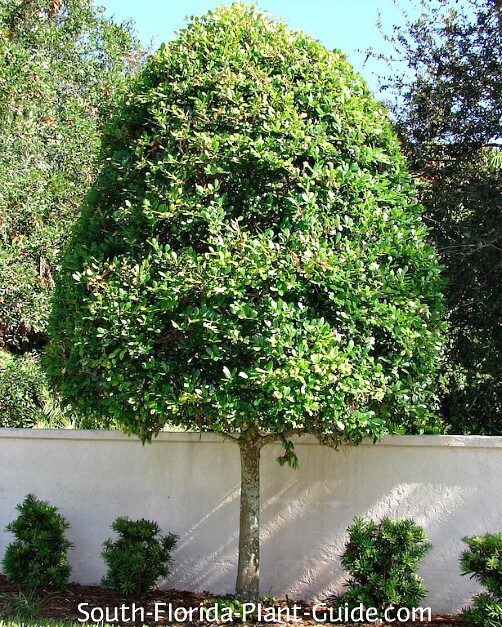
It may seem odd to plant such an "up-North plant" in a subtropical landscape.
But these naturally beautiful trees mix surprisingly well with the tropical foliage and bright flowers of South Florida.
Hollies can be shrubby or tree like, shaped for a manicured appearance into teardrops, lollipops (like the East Palatka holly pictured above) or even small shade trees.
Or they can be left to grow naturally - unclipped holly trees often have an attractive weepy look with full-to-the-ground foliage.
Just one makes an ideal small-space specimen. They're also delightful grown as a living hedge, or single accent for a garden area.
A holly tree works wonders in a formal setting or adds a stately touch to a more informal one.
Glossy green leaves and red (or orange) berries are the trademark of most holly trees.
To be sure you're getting a berry-producing female plant, buy in winter when the berries are present.
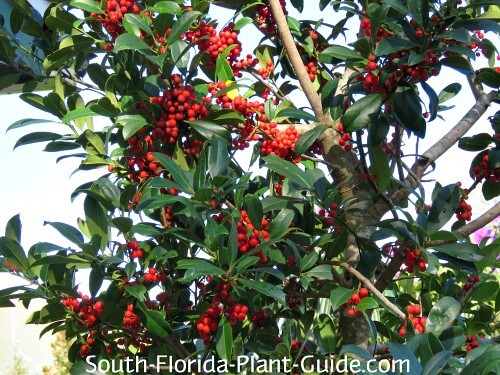
Most hollies prefer Zone 9B, though some can take the sweltering heat and humidity of Zone 10.
Nellie Stevens holly tree
Ilex x 'Nellie R. Stevens'
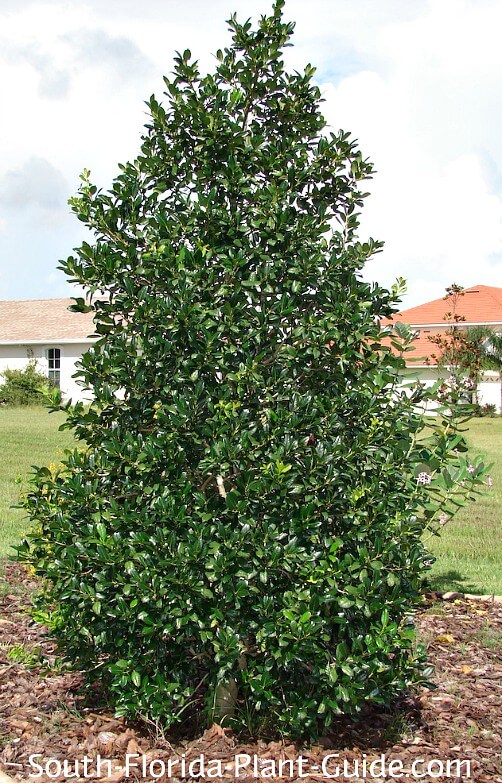
This is a classic holly with a naturally pyramidal shape - no pruning required.
One of the best holly trees for South Florida because it doesn't mind our heat and humidity, Nellie is cold hardy and does fine in Zone 9 or Zone 10.
It's a slow grower to 15 to 20 feet. The deep green leaves are set off by orange berries in winter.
This tree looks best left full to the ground, and it's moderately drought tolerant once established.
Yaupon holly tree or "Weeping Holly"
Ilex vomitoria 'Pendula'
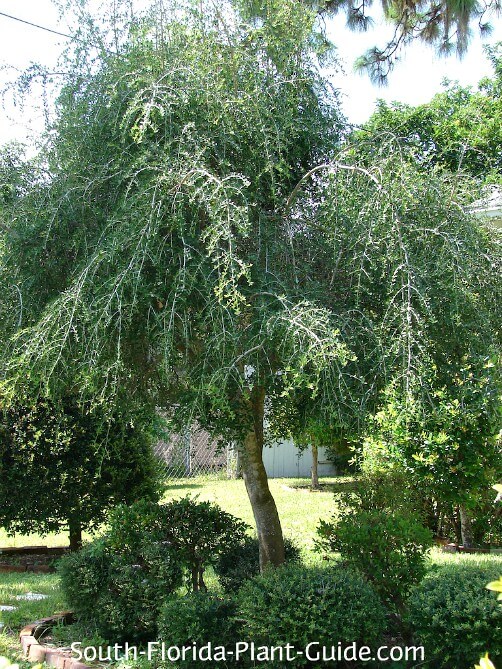
Each tree of this variety is unique - with a funky avant-garde shape especially when young - but all have an extreme weeping habit.
You can trim a bit here and there but it's best left alone to take on its own natural shape.
A tough, hardy native plant which can take dry conditions to occasional spells of "wet feet," weeping holly grows slowly to 15 to 20 feet.
The tree has an open growth habit which shows off the dark orange winter berries. It's cold hardy and prefers Zone 9B and bordering areas of Zone 10.
Eagleston and East Palatka holly
Ilex x attenuata
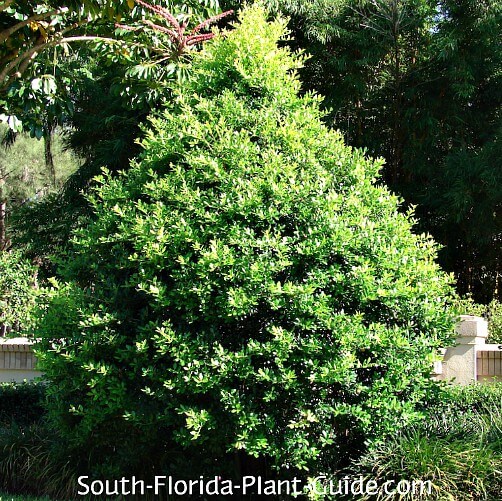
These are elegant look-alike hollies that produce loads of red berries.
They're cold tolerant and prefer the cooler temps of Zone 9B and bordering areas of Zone 10A.
East Palatka can reach 30 feet. Eagleston grows to about 20 feet. Both are slow growers that take well to shaping but also look beautiful untrimmed.
Eagleston is now more commonly sold than East Palatka due to pest problems.
Dahoon holly
Ilex cassine
Dahoons can reach heights of 20 to 30 feet with a moderate growth rate.
The beautiful bright green foliage looks its best when it's kept clipped for denser growth.
This tree is moderately salt-tolerant, and it's cold hardy - best in Zone 9B and cooler areas of Zone 10A.
A dahoon needs regular irrigation and can take "wet feet," since its natural environment is swampy areas.
It produces red berries but you'll need both male and female plants to produce them.
Plant specs
A holly does best in full to part sun.
All are cold tolerant and actually do best in Zone 9B, except for Nellie Stevens which can thrive in both Zones 9 and 10.
The majority are slow to moderate growers - yaupon holly is especially slow - though some sources describe Nellie Stevens as moderate to fast.
Ultimate size depends on each variety...anywhere from 15 to 40 feet.
These trees are evergreen, and all but dahoon are moderately drought-tolerant once they're well-established.
The leaves of most are somewhat prickly - these are hollies after all - and the berries attract birds.
Plant care
Add top soil (or organic peat humus) and composted cow manure to the hole when you plant.
No trimming is needed for most of these trees unless you want a specific shape.
Don't go overboard with the trimmers, though...no more than 2 or 3 times a year is best for the health of the tree.
Water on a regular basis with time between waterings for the soil to dry out a bit.
Fertilize 3 times a year - in spring, summer and autumn - with a good granular fertilizer.
Plant spacing
Place these trees at least 8 feet from the house to allow for future growth spread.
Allow at least 4 feet between a holly and the nearest shrub. Groundcovers, though, can go closer.
For planting in a row, place hollies 6 feet apart. Nellie Stevens can be situated as close as 4 feet apart. Yaupon looks best as a single specimen rather than in group plantings.
Come in from a walk or drive at least 6 feet.
Landscape uses for holly trees
- single yard specimen
- architectural accent
- lining the patio for privacy
- anchor for a mixed garden bed
- along a driveway
- large "hedge"
- backdrop for smaller plants
- near the entry to decorate for Christmas
GOOD SNOWBIRD PLANT? YES
COMPANION PLANT SUGGESTIONS: Avoid planting just beneath the tree to allow for growth. You can use groundcovers such as jasmine minima (Asiatic jasmine) to set off the tree once it's well established. Or plant small shrubs such as loropetalum, juniper, drift rose.
Other trees you might like: Japanese Blueberry, Southern Red Cedar
Take a break!
The ultimate guide to low-maintenance plants
and landscaping!
An ebook by
Chase Landre
author of
South-Florida-Plant-Guide.com
Learn more!
Get a greener thumb!
Want to learn more about South Florida planting, watering, fertilizing and dealing with weeds and pests?
See our Gardening How-To section for answers!
Get instant curb appeal!
An ebook by
Chase Landre
author of
South-Florida-Plant-Guide.com
Learn how to get instant curb appeal with fast growing plants and landscaping techniques!



